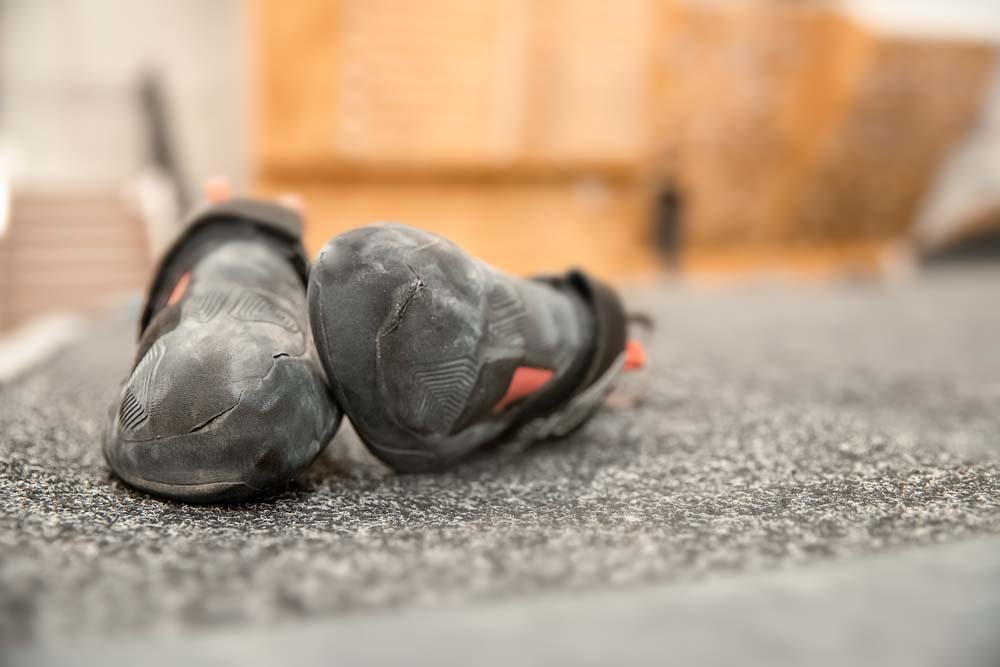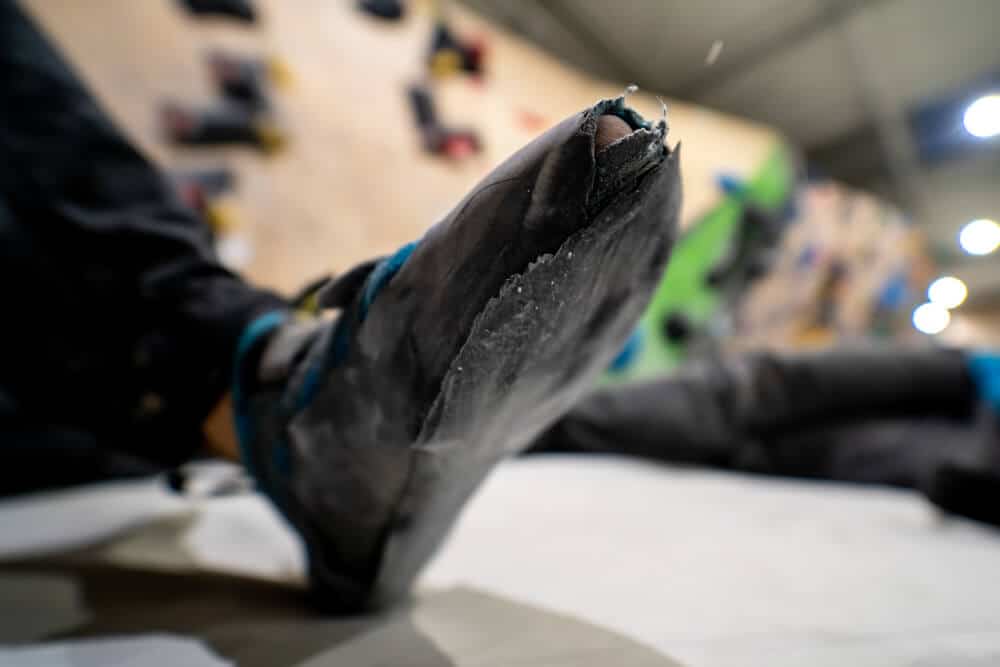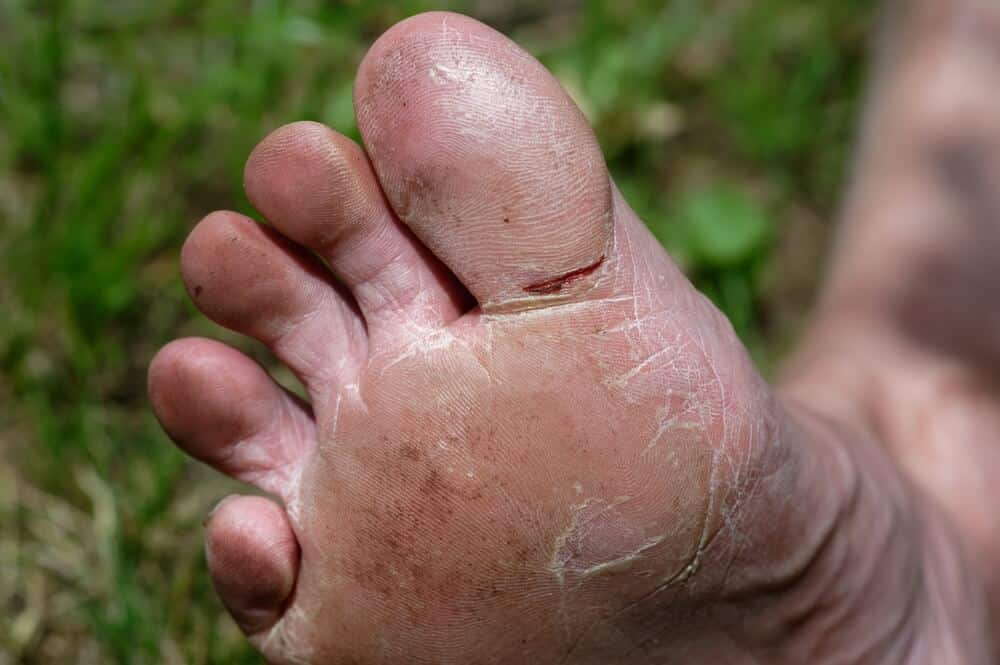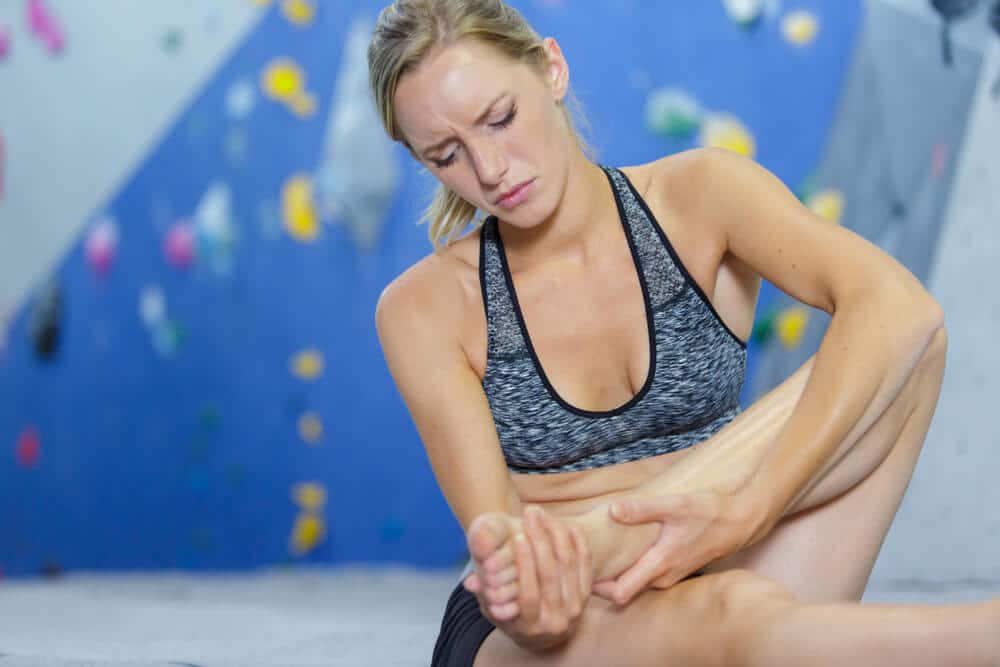It’s easy to forget how essential your feet are for rock climbing. Often, fingers and upper body muscles get all the attention. However, your feet and toes are one of the keys to successful climbing! After all, that’s why we spend so much money on climbing shoes.
There are a few different types of problems that can arise in relation to your feet.
Many rock climbers experience foot problems due to their shoes, especially small shoes. Additionally, you can get overuse injuries in your feet from rock climbing, or you can experience a traumatic injury, such as a fall.
Another category of foot problems that can arise from rock climbing is skin problems: blisters, sores, or infections on the feet. Let’s dive into each of these categories and how to prevent and care for foot pain and problems that rock climbers often experience.
Shoe Related Foot Problems
Wearing climbing shoes can actually cause quite a few foot problems.
Downsizing is a common practice in the climbing world: many rock climbers have an average shoe size difference of 2 or 3 sizes between their street shoe size and their climbing shoe size.
Wearing tight shoes like this can cause climbing related injuries.
For example, it’s common to develop corns (hardened and thickened layers of skin) in places where your climbing shoe is especially tight. Tight climbing shoes can also contribute to the development of bunions, which are bony protrusions that grow on the toe joints.
Additionally, if your climbing shoes are putting too much pressure on your heel, you can develop achilles bursitis. This is an inflammation of the fluid-filled sac that is behind the achilles tendon. If the toe box of your shoe is too small, you may develop a variety of joint problems, such as injury to the big toe joint.
Avoiding Shoe Related Issues
Many rock climbers know that wearing tight, aggressive shoes can have lots of performance benefits. However, it’s a fine line between better performance and the need to care for your feet.
What many climbers do to address this is to have at least two pairs of shoes: one that’s more aggressive and performance oriented (and maybe slightly painful), and one that’s comfortable and doesn’t put excessive pressure on your feet.
Then, use the comfortable shoe whenever you can! Wear it as you warm up, on easier climbs, and anytime you don’t absolutely need your aggressive shoes. You’ll preserve your foot health, and this strategy also has the added benefit of prolonging the life of your nice (and likely expensive) shoes. And wear your street shoes when you can!
Dealing with Blisters and Sores
Oftentimes, climbing shoes can cause blisters or sores on your feet. It’s important to watch out for this, as if left untreated they can lead to long-term foot deformities. If you notice a blister beginning to form, try switching climbing shoes so that the pressures that are being put on your foot are different. You can also try taping the blister or using Moleskin to protect it.
Additionally, if you notice calluses or corns beginning to form, try sanding them down with sandpaper or a nail file. If you sand them down at the beginning of them forming, you can prevent them from becoming a larger issue.
Overuse Injuries
When we think about climbing overuse injuries, we usually think about things like climber’s elbow or a pulley rupture. However, foot and ankle injuries are more common than you might think.
The toes are one common place where this can occur. Some climbers may experience swelling and inflammation of the big toe joint.
If symptoms are chronic and persist after climbing, it may be hallux rigidus, which is basically a case of osteoarthritis in the big toe knuckle. This means that the cartilage that is supposed to protect the bones in the toe has been worn away, and the bones are then left to grind against each other, causing pain.
This condition can affect younger climbers, though it is most common in climbers over 30. While most common in the big toe joint, climbers can experience toe pain in any of their digits.
Another overuse injury that often occurs in climbers is achilles tendinitis. This injury to the Achilles tendon can occur when too much load is placed on the tendon. It’s a progressive condition, so the pain will be mild at first and worsen with continued use. Standing on your toes on small holds puts quite a bit of strain on the Achilles tendon, as well as other tendons in the feet and ankles. Plantar fasciitis is another of the many feet injuries that can occur from too much time standing on your toes.
Avoiding Overuse Injuries
So, how can you avoid these common climbing injuries? The most important thing with overuse injuries is to listen to your body. If you start to feel pain in your big toe, Achilles tendon, or anywhere else, make sure to rest. It’s common among climbers to want to continue to train even when something is hurting, but this is how overuse injuries become serious. Seeking physical therapy can also be helpful for addressing these types of climbing related injuries.
Another technique for avoiding injury to the lower body is to vary the type of climbing you’re doing. Most overuse injuries to the feet occur from too much time spent standing on your toes, something common on vertical or slabby climbs. If you start to feel pain in your feet, try switching up the type of terrain you’re climbing. Overhung terrain doesn’t require you to stand on your feet, so that can be a good way to allow your foot issues to heal while still being able to climb.
Skin and Nail Infections
It’s very common to experience a variety of skin and nail problems from rock climbing. Sometimes, this is due to wearing climbing shoes that are overly tight, but it can happen even with well-fitting shoes. When you climb, your feet spend a lot of time in sweaty shoes. This can lead to a variety of infections, including fungal skin infections such as athlete’s foot, and infections of the nail bed.
Avoiding Infections
So, how can you care for your feet in order to avoid infection? The number one strategy is to minimize the time spent in your climbing shoes and wear normal shoes when possible. Take off your shoes in between attempts; this way your feet won’t be in a sweaty environment for quite so long. A street shoe will not create the same sweaty environment that a climbing shoe will.
Additionally, if you do notice any signs of infection, address it right away. For example, athlete’s foot can be identified by itchy white patches between your toes. You can buy an over the counter anti fungal cream that can treat the infection. The sooner you begin treatment, the easier it will be to cure the infection.
Acute Injuries
Another common way climbers feet become hurt is by acute injuries. Common acute injuries include ankle sprains related to falling as well as fractures to bones in the feet. These types of foot injuries occur due to one specific event, usually a bad fall.
Often, ankle injuries related to falling occur while bouldering, since every fall is a ground fall. Ground falls are risky since the impact can easily cause ankle sprains or other issues. However, traumatic falls sport climbing can cause acute injuries too. For example, if a climber hits the wall as they fall, it’s common to hurt an ankle.
Fractures and sprained ankles are rock climbing injuries that every climber wants to avoid. They can take a long time to heal, especially fractures. Climbers who experience fractured bones in their feet must be careful to avoid weight bearing, and in some cases this type of injury may require surgical intervention.
Avoiding Acute Injuries
You can’t ever fully eliminate the risk of these injuries, but there are precautions you can take to minimize the chances of one occurring. It’s essential to learn how to fall safely, both in bouldering and sport climbing. Experienced climbers are good at falling, and they know how to do it in a way that will keep them safe. Try watching some videos and practicing safe falling techniques when climbing in the gym.
It’s also important to risk assess, especially when climbing outside! When you’re bouldering, make sure that the falls will be safe and that you have adequate pads to protect the climb. Utilize spotting to ensure a safe fall. When sport climbing, look for places where a weird or risky fall may occur and talk with your belayer about how to keep you safe. In general, giving soft catches helps prevent climbers from slamming into the wall and hurting their ankles.
Afterthoughts – Take Care of Your Pinkies!
Rock climbing injuries can be painful, and it’s good to do what you can to prevent them. Although foot injuries are may not come to mind first, caring for climbers feet is an important piece of healthy rock climbing!
Make sure to minimize your time in tight climbing shoes, and take off your climbing shoes whenever you can. Additionally, pay attention to signs of overuse injuries, such as pain in your big toe or heel. And remember to care for your skin, watch out for signs of infection, and learn how to fall safely to avoid acute injuries. With those tips in mind, you’re on the path to healthier feet!














